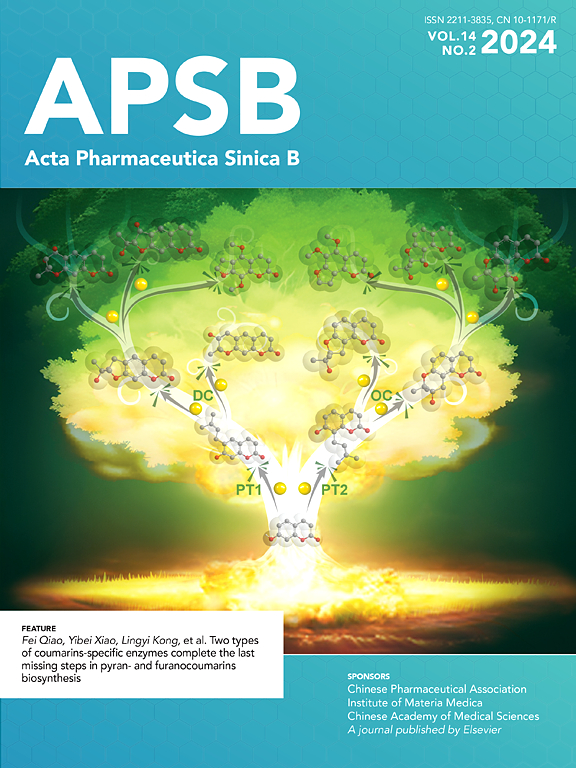衰老微环境中的免疫调节机制:针对衰老相关的分泌表型进行癌症免疫治疗
IF 14.6
1区 医学
Q1 PHARMACOLOGY & PHARMACY
引用次数: 0
摘要
衰老微环境作为肿瘤发生和发展的关键驱动因素,通过其核心特征之一-衰老相关分泌表型(senescence-associated secretory phenotype, SASP)在肿瘤免疫调节中起着关键作用。SASP由多种白介素、趋化因子、蛋白酶和生长因子组成。它最初通过旁分泌机制诱导周围细胞进入衰老状态,从而在组织微环境内产生持续的炎症刺激和信号放大效应。此外,这些分泌因子激活关键信号通路,如NF-κB、cGAS-STING和mTOR,这些信号通路调节免疫相关分子(如PD-L1)的表达,促进免疫抑制细胞(包括调节性T细胞和髓源性抑制细胞)的募集。这一过程最终促成了免疫抑制肿瘤微环境的形成。此外,本文还探讨了针对SASP的潜在抗肿瘤免疫治疗策略及其相关的分子机制,包括抑制SASP分泌或消除衰老细胞的方法。尽管这些策略在某些肿瘤模型中显示出希望,但肿瘤类型之间的高度异质性可能导致对sasp靶向治疗的不同反应。这突出了进一步研究适应性分层和个性化治疗方法的必要性。针对衰老微环境中的免疫调节机制,特别是sasp,具有推进未来抗肿瘤治疗的巨大潜力。本文章由计算机程序翻译,如有差异,请以英文原文为准。

Immunoregulatory mechanisms in the aging microenvironment: Targeting the senescence-associated secretory phenotype for cancer immunotherapy
The aging microenvironment, as a key driver of tumorigenesis and progression, plays a critical role in tumor immune regulation through one of its core features—the senescence-associated secretory phenotype (SASP). SASP consists of a variety of interleukins, chemokines, proteases, and growth factors. It initially induces surrounding cells to enter a state of senescence through paracrine mechanisms, thereby creating a sustained inflammatory stimulus and signal amplification effect within the tissue microenvironment. Furthermore, these secreted factors activate key signaling pathways such as NF-κB, cGAS–STING, and mTOR, which regulate the expression of immune-related molecules (such as PD-L1) and promote the recruitment of immunosuppressive cells, including regulatory T cells and myeloid-derived suppressor cells. This process ultimately contributes to the formation of an immunosuppressive tumor microenvironment. Furthermore, the article explores potential anti-tumor immunotherapy strategies targeting SASP and its associated molecular mechanisms, including approaches to inhibit SASP secretion or eliminate senescent cells. Although these strategies have shown promise in certain tumor models, the high heterogeneity among tumor types may result in varied responses to SASP-targeted therapies. This highlights the need for further research into adaptive stratification and personalized treatment approaches. Targeting immune regulatory mechanisms in the aging microenvironment—particularly SASP—holds great potential for advancing future anti-tumor therapies.
求助全文
通过发布文献求助,成功后即可免费获取论文全文。
去求助
来源期刊

Acta Pharmaceutica Sinica. B
Pharmacology, Toxicology and Pharmaceutics-General Pharmacology, Toxicology and Pharmaceutics
CiteScore
22.40
自引率
5.50%
发文量
1051
审稿时长
19 weeks
期刊介绍:
The Journal of the Institute of Materia Medica, Chinese Academy of Medical Sciences, and the Chinese Pharmaceutical Association oversees the peer review process for Acta Pharmaceutica Sinica. B (APSB).
Published monthly in English, APSB is dedicated to disseminating significant original research articles, rapid communications, and high-quality reviews that highlight recent advances across various pharmaceutical sciences domains. These encompass pharmacology, pharmaceutics, medicinal chemistry, natural products, pharmacognosy, pharmaceutical analysis, and pharmacokinetics.
A part of the Acta Pharmaceutica Sinica series, established in 1953 and indexed in prominent databases like Chemical Abstracts, Index Medicus, SciFinder Scholar, Biological Abstracts, International Pharmaceutical Abstracts, Cambridge Scientific Abstracts, and Current Bibliography on Science and Technology, APSB is sponsored by the Institute of Materia Medica, Chinese Academy of Medical Sciences, and the Chinese Pharmaceutical Association. Its production and hosting are facilitated by Elsevier B.V. This collaborative effort ensures APSB's commitment to delivering valuable contributions to the pharmaceutical sciences community.
 求助内容:
求助内容: 应助结果提醒方式:
应助结果提醒方式:


